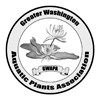GWAPA – May 2008 Meeting
May 24th, 2008 Nancy Rybicki of the US Geological Survey spoke at GWAPA’s May 2008 meeting in Silver Spring, MD. Being the first club meeting held at a meeting hall, rather than a member’s home, we had a pretty good turn out with 27 members showing up. Nancy gave an excellent presentation detailing the current state of submerged aquatic vegetation (SAV) in the Potomac River system, which flows into the Chesapeake Bay.
Nancy Rybicki of the US Geological Survey spoke at GWAPA’s May 2008 meeting in Silver Spring, MD. Being the first club meeting held at a meeting hall, rather than a member’s home, we had a pretty good turn out with 27 members showing up. Nancy gave an excellent presentation detailing the current state of submerged aquatic vegetation (SAV) in the Potomac River system, which flows into the Chesapeake Bay.
At first, she described why SAV is so important to the ecosystem. In tests, they have determined that in rivers that are lush with aquatic plant life, 10-60% of all nitrate in the waters are absorbed by the plants. This prevents these extra nutrients from eventually ending up in the Bay. So, her team worked to find out what the ideal conditions for SAV to survive are, and they found that ultimately, light is an important factor. The amount of light (13% needed by freshwater SAV) that reaches the plants is dependent on a number of factors. Water clarity is vital, but can be disturbed by algae blooms, wind storms, or high water flow that stirs up and introduces silt into the water.
Fortunately, since the 1980’s, many areas are experiencing a period of increased SAV. Improved sewage treatment methods have reduced that amount of nitrate that’s introduced directly into the Potomac. Even when faced with threats from exotic plants, such as Hydrilla or water lettuce, beds of Wild Celery (Val. americana) continue to do well in many parts of the river. This can largely be attributed to the fact that Val’s tubers provide energy stores that let them establish themselves in the riverbeds earlier in the season than the exotic plants can. Of course, environmental conditions vary yearly, and the state of the Val./Hydrilla competition does likewise.
I was interested to find out that one of the local native plants Nancy referred to was Stargrass. In the aquarium hobby, this is of course, Heteranthera zosterifolia, but to the local scientific community, they are referring to Heteranthera dubia. In addition, Nancy has helped on many efforts to introduce native plants back into parts of the Anacostia River to ensure a diversified selection of SAV in the river. By ensuring multiple native plants, they are increasing the likelihood that one of them will outcompete the exotic plants, and increase the health of the water ways.
Also, Nancy wanted to stress to all hobbyists that they continue to enjoy the aquatic plant hobby, but properly dispose of their plant trimmings. This means, throwing them in the trash or compost bin, instead of flushing them down the toilet, or dumping them into a local stream or river. Even better, use more native plants in your tanks. All in all, a very interesting talk about the plants/habitat in our own backyard.
May 27th, 2008 at 9:11 am
Oh now I’m sad I missed this one. I was embroiled in pond issues all day and completely forgot!